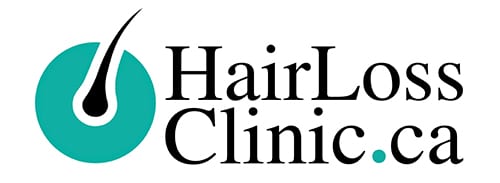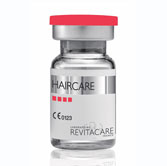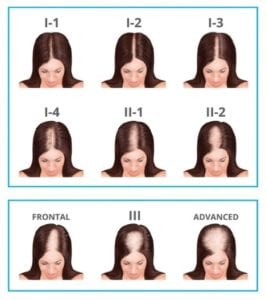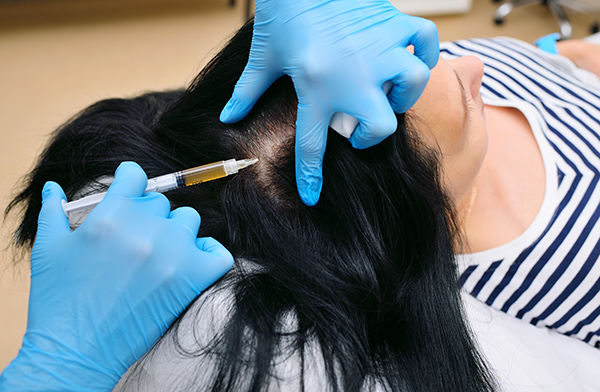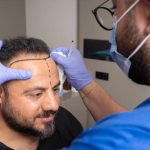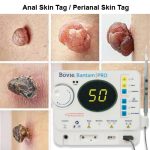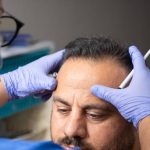
WOMENS HAIR LOSS TREATMENT AND ASSESSMENT
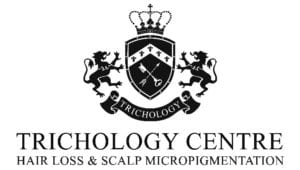
FREE ONLINE WOMENS HAIR LOSS AND ASSESSMENT FORM
Are you experiencing womens hair loss or scalp issues? Get a Certified Trichologist to assess and help treat your condition in Toronto and Greater Toronto Area. Please complete our online Trichology Assessment Form to get started now.
Womens hair loss can be psychological devastating and deeply distressing for women. About one third of women experience hair loss at some time in their lives. For postmenopausal women it is as high as two thirds. There are many causes of hair loss in women. Below are the most common causes and solutions.
TYPES OF WOMENS HAIR LOSS
- Female Pattern Hair Loss (Androgenic Alopecia)
- Alopecia Areata
- Alopecia Totalis
- Alopecia Universalis
- Central Centrifugal Cicatricial Alopecia (CCCA)
- Cicatricial Alopecia (scarring alopecia)
- Frontal Fibrosing Alopecia (FFA)
- Lichen Planopilaris
- Telogen Effluvium
- Traction Alopecia
- Trichotillomania (Hair-pulling disorder)
There are many reasons why women can lose their hair. The average scalp contains approximately 100,000 hairs. On a typical day, women can lose around 50 to 100 hairs. But if more hairs are shed each day, thinning hair becomes more and more noticeable. Fortunately, there are treatments available for most female hair loss problems. Some hair loss conditions are only temporary, and the hairs will normally grow back on its own once the issue has been resolved. Other hair loss conditions, such as female pattern baldness, require treatment to help maintain and stimulate hair growth.
FEMALE PATTERN HAIR LOSS / HAIR LOSS IN WOMEN
Female pattern hair loss, also known as FPHL, female pattern baldness, or female pattern alopecia, is a type of androgenetic alopecia that affects women. Androgenetic alopecia is a genetic condition that affects both men and women. For hair loss women, the pattern of hair loss is different than that of men. Male pattern hair loss pattern looks like a horseshoe, with the frontal hairline receding into the back of the scalp. For most men, the side and back of the hairs remain intact. For female pattern hair loss, the pattern is different. Womens hair loss is a diffused hair loss all over the scalp, starting from the top of the scalp and progressively thinning throughout the entire scalp region.
Androgenetic alopcia causes miniaturization of the hair. Over time, these hairs look so small that you think they are gone. For men, the miniaturization affects all the affected hairs in the horseshoe pattern. For women though, the miniaturization doesn’t affect all the hairs. So even though hair thinning is apparent, most women still maintains their frontal hair line unlike male pattern hair loss. For more information Click Here
ALOPECIA AREATA
Alopecia areata is one type of hair loss that doesn’t look like the typical diffused pattern seen in other forms of womens hair loss. With alopecia areata, bald patches of your scalp are visible where the hairs have fallen out. The size of the hair loss usually looks like small coin size, round patches, but in more severe causes, it can affect the whole scalp and body. It is an auto-immune disorder that can affect both men and women at any age.
Hair loss that causes total hair loss to the scalp is called alopecia totalis. Total hair loss to your whole body is called alopecia universalis. The most common form of alopecia areata treatment is the use of corticosteroids, anti-inflammatory drugs that can suppress the immune system. These are commonly administered through local injections, topical ointment application, or orally. For more information Click Here
ALOPECIA TOTALIS
Alopecia totalis is characterized by a loss of hair to the entire scalp. It is an advanced form of Alopecia Areata which is the more common of the two. Alopecia totalis affects about one in two thousand people, making it a rare skin disease. It is a non-scarring alopecia without the complete destruction of the hair follicle. Hair regrowth can be expected as the hair follicles are not destroyed like scarring alopecia (cicatricial alopecia). For more information Click Here
ALOPECIA UNIVERSALIS
Alopecia universalis is the advanced form of alopecia areata, a condition that leads to round patches of hair loss.
Alopecia universalis is an autoimmune condition that causes complete hair loss throughout the scalp and body.
Patient with alopecia universalis usually start off with alopecia areata patchy with coin sized bald patches to the scalp. However, as the condition worsens, alopecia totalis and alopecia universalis occurs.
Alopecia universalis is a rare skin disease. Statistics show that only 1 in 4000 people get this disease. It is estimated of the number of people with alopecia areata who eventually develop alopecia totalis or unversalis or range from 7% to 25%. For more information Click Here
CENTRAL CENTRIFUGAL CICATRICIAL ALOPECIA (CCCA)
CCCA is a specific type of scarring (cicatricial) alopecia resulting in permanent hair loss in women. It is the most common form of hair loss seen primarily in black women of African descent. Hair loss in CCCA begin at the vertex and middle region of the scalp and then spread centrifugally in all directions.
This is different than other female hair loss conditions such as female pattern baldness and telogen effluvium, which is diffused and evenly spaced.
All CCCA variants have the following characteristics in common:
- CCCA is predominantly centered on the crown or vertex of the scalp.
- CCCA is a progressive disease that spans over years or decades.
- CCCA progresses in a symmetrical way.
For more information Click Here
ALOPECIA UNIVERSALIS
Cicatricial alopecia, also known as scarring hair loss, is a hair loss condition caused by a group of rare disorders that destroy the hair follicles and replacing it with scar tissue, resulting in permanent hair loss.
Hair loss due to cicatricial alopecia in not rare, and is seen in about 7% of adult men and women. It is rarely seen in children.
It is characterized by inflammation, progressive hair loss and eventual formation of scar tissue. The scarring is not seen on the scalp but underneath the skin in the hair follicles. Along with the hair follicles the sebaceous glands are also affected. In the areas affected, the skin is bald, smooth, and shiny, and pores are absent because of complete loss and destruction of hair follicles.
Cicatricial alopecia is unpredictable. It can occur gradually over time or can come suddenly. It usually starts with a small bald spot which eventually spreads over the scalp. It is often accompanied by pain and itching but not in all cases. For more information Click Here
TELOGEN EFFLUVIUM
Telogen effluvium is a temporary hair loss condition that can affect women. Telogen effluvium looks very similar to female pattern hair loss in that they both show hair thinning throughout the scalp area. Your hair grows in cycles. When your body goes through something traumatic, it can change the growth cycles of the hair. About 90% of your hairs are in the anagen phase (growth phase) or transitional phase (catagen), but any trauma to your body could cause it all to shift to the resting phase (telogen). For more information about womens hair loss – telogen effluvium Click Here
FRONTAL FIBROSING ALOPECIA
Frontal Fibrosing Alopecia (FFA) is a slowly progressive primary cicatricial alopecia in which hair loss follows a pattern characterized by progressive recession of the frontal hairline and often the eyebrows. Approximately half of all affected people experience loss of eyebrows.
The skin in the affected area often looks normal but may be pale, shiny or mildly scarred. In some cases, women with FFA also have FPHL (female pattern hair loss), which is associated with diffused thinning of hair on the scalp due to increased hair shedding. It is a subtype of lichen planopilaris, a scarring alopecia that affects predominantly postmenopausal women, although men and premenopausal women may also be affected. For more information Click Here
LICHEN PLANOPILARIS
Lichen planopilaris (LLP) is a type of cicatricial alopecia (scarring alopecia) that occurs when a relatively common skin disease, known as lichen planus, affects areas of skin where there are hair follicles. Lichen planopilaris destroys the hair follicle and then replaces it with scar tissue, resulting in permanent hair loss.
LLP is a chronic inflammatory disease resulting in patches of hair loss on the scalp that may be burning and itching. The distinct feature of lichen planopilaris is the bald patches and lesions with erythema and scale on the scalp. The lesions are reddish in colour and have a crusty appearance, showing scaling towards the periphery. Hair follicles in the affected areas show inflammation. The bald spots range from a few to many anywhere on the scalp and the pattern of hair loss is greatly varied. Small bald spots eventually fuse to form larger areas of hair loss.
For more information Click Here
TRACTION ALOPECIA
Traction alopecia hair loss is due to trauma to the hair follicles. It is primarily a womens hair loss issue. This can be caused by many hairdressing practices such as over processing of your hair from chemicals, dyeing, bleaching, over brushing, and using a hot hair dryer on a regular basis. Poor hair styling habits also contribute to trauma to the hair follicles. This can include wearing your hair in a tight ponytail, braiding, and adding hair extensions. Once you stop and correct your hairdressing issues, your hair should start growing back. For more information Click Here
TRICHOTILLOMANIA
Trichotillomania is a hair pulling disorder that causes hair loss mainly in younger girls. Hair pulling can occur in any region of the body, but the primary affected area is the scalp. Trichotillomania may be difficult to assess as many people with this disorder deny that they are doing it. The urge to pull hair is a mental disorder and the best treatment is cognitive behavioral therapy. Once the behavior stops, the hair should grow back. (We offer a device that can help to change the persons hair pulling behavior, please contact us for more information about trichotillomania). For more information about hair loss in women – trichotillomania Click Here
BEST HAIR LOSS TREATMENT FOR FEMALE
WOMENS HAIR LOSS TREATMENT – AAPE® STEM CELL THERAPY
AAPE® is a stem cell technology that promote hair follicles regeneration and prompt restoration. AAPE® is mixture of refined growth factors extracted from human adipose-derived stem cells conditioned media and induces proliferation of dermal papilla cells of human hair follicles to to increase total hair count and make hair regrow twice faster. AAPE® has:
- US FDA, CFDA Approval
- PCPC US registration
- 15 International SCI journals
- 28 Patents registration worldwide
The use of AAPE®, “fat” or adipose-derived stem cells conditioned media as a hair loss treatment as been used successfully for hair loss in women. The safe and non-invasive treatment is described in the following journal article, including a new study and scientific analysis of hair growth measurements as well as photos of the results, as published in the International Journal of Dermatology. This advanced stem cell-derived protein extract called AAPE® can now be applied in a clinical setting without discomfort or downtime as a lunch-hour session at the Toronto and Richmond Hill TRICHOLOGY CENTRE | Hair Loss Clinic. For more information Click Here
WOMENS HAIR LOSS TREATMENT – PHARMA HERMETIC HAIR RECOVERY PROGRAM®
Pharma Hermetic Hair Recovery Program® works at revitalizing the hair bulb and obtaining a greater thickness and strength. It helps strengthen the anchorage of the root, and re-balance the scalp.
In addition, the Hair Recovery Program® SP55, enhance the growth of new hair and activates dormant follicles thanks to its effective active ingredients. Providing all the necessary nutrients to repair the weakened and brittle hair. After the treatment, the hair becomes thicker and more voluminous.
We rely on ingredients suitable to penetrate the scalp and stop hair loss.
- Thicker hair.
- More density.
- No side effect.
- Topical application.
- Lasting results.
For more information Click Here
NOURKRIN® WOMANS HAIR LOSS TREATMENT
If you’re worried about certain hair loss medications that contain ingredients that may cause some side affects such as Minoxidil, we offer a hair loss treatment called Nourkrin®. Nourkrin® contains natural ingredients and has been clinically proven to help thinning hair. The key active ingredients are marine-based extracts of proteins and polysaccharides that have been combined with silica, vitamin C, and horsetail extract.
Developed by scientists in Finland, Nourkrin® has been the subject of many double blind, placebo-controlled clinical studies, the latest of which showed that 77% of all participants reported a positive effect during a six-month treatment period and their hair count increased by an average of 35.7%. Nourkrin® Woman with the unique Marilex® helps support, normalize and maintain the Hair Growth Cycle by carefully providing the correct nutrients to the hair follicles. Nourkrin® is the only product worldwide containing Marilex® (which has a unique and protected composition structure), and consumers should therefore beware of imitation products that claim to deliver similar effects with so-called ‘marine proteins’ or ‘marine extracts’ – as these are not the original, scientifically tested Marilex®.
Today, the award-winning Nourkrin® Woman is appreciated by women around the world. Nourkrin® Woman is completely safe and 100% drug-free. You can get the Nourkrin® Woman hair loss treatment at the Toronto and Richmond Hill TRICHOLOGY CENTRE | Hair Loss Clinic. For more information Click Here
PLATELET-RICH PLASMA – PRP HAIR TREATMENT
PRP WOMANS HAIR LOSS TREATMENT
Platelet Rich Plasma (PRP) therapy is an effective, non-surgical treatment for hair loss in women, leveraging the healing potential of the body’s platelets. In this procedure, a patient’s blood is drawn, centrifuged to extract platelet-rich plasma, and injected into the scalp areas affected by hair loss.
The growth factors in platelets stimulate cell proliferation, differentiation, and new blood vessel formation, creating an environment conducive to hair growth. Additionally, platelets modulate inflammatory responses, potentially reducing damage to hair follicles.
Clinical studies show significant improvements in hair density, terminal/vellus hair ratio (indicating successful hair regrowth), and hair diameter post-PRP treatment. Most patients report high satisfaction due to improved hair growth and associated self-esteem boosts.
For more information about PRP for womens hair loss treatment CLICK HERE
THERADOME® LASER HAIR THERAPY
The Theradome® laser for womens hair loss treatment brings you the world’s most advanced laser technology for hair growth from the comfort of your own home. Unlike Light Emitting Diodes (LEDs) devices, our laser light targets the stem cells at the base of hair follicles. This allows the formation of a new photonic pathway that can restore hair to a healthy state. Theradome® one-of-a-kind laser hair helmet was engineered based on four crucial scientific criteria, which together provide the most powerful and efficacious laser hair growth treatment available.
Only lasers produce coherent light, meaning their light waves are aligned and traveling in synchronicity. Laser light is needed to penetrate the scalp at a depth of 3 – 5 mm and reach the base of a hair follicle. No other light source (i.e. – LEDs) can achieve this. By treating the base of hair follicles, our proprietary cold laser hair growth treatment ensures the mitochondria of hair cells is stimulated. The mitochondria then produces cell energy that is harnessed by hair follicles. You can purchase the Theradome® hair loss laser therapy device at the Toronto and Richmond Hill Trichology Centre | Hair Loss Clinic. For more information Click Here
SMP® SCALP MICROPIGMENTATION FOR WOMEN
If you suffer from a scarring alopecia (no hair growth in the bald areas), or just want to have a thicker looking hair, there is another option called SMP® Scalp Micropigmentation. It is a technique in which pigment is deposited into the dermal layer of the skin on the scalp replicating the look of hair follicles. When viewed from close, the pigment dots appear like real hair follicles. With female hair loss, SMP® can be done in between the existing hair follicles to add thickness and reduce areas where more scalp is showing. SMP® works best for women with dark brown or black hair.
For more information Click Here
Q & A
What is a trichologist, and how can they help with women’s hair loss?
A trichologist is a specialist in the science of human hair’s structure, function and diseases. At the Trichology Centre, they can assess and treat various conditions related to hair loss in women by completing an online Trichology Assessment Form.
What is the average number of hairs a woman can lose daily?
Women can lose around 50 to 100 hairs on a typical day. If more hairs are shed daily, it may result in noticeable thinning.
What is female pattern hair loss?
Female pattern hair loss, also known as FPHL, is a genetic condition that leads to diffused hair loss all over the scalp, starting from the top and progressively thinning throughout the entire scalp region. It is a type of androgenetic alopecia.
How does Alopecia Areata differ from other women’s hair loss types?
Alopecia Areata causes hair to fall out in circular patches on the scalp, leading to noticeable bald spots. It’s an autoimmune disorder that can affect men and women at any age, which differs from the diffuse thinning seen in other forms of women’s hair loss.
What is Alopecia Totalis and Alopecia Universalis?
Alopecia Totalis is characterized by the absence of hair on the scalp, while Alopecia Universalis refers to the complete absence of hair on the entire body. Both are advanced forms of Alopecia Areata.
What is Central Centrifugal Cicatricial Alopecia (CCCA)?
CCCA is a type of permanent hair loss that primarily affects black women of African descent. Hair loss begins at the vertex and middle region of the scalp, then spreads in all directions. This differs from conditions like female pattern baldness, which is diffused and evenly spaced.
What characterizes Cicatricial Alopecia?
Scarring hair loss, medically called cicatricial alopecia, occurs due to uncommon conditions that damage hair follicles and replace them with scar tissue, leading to irreversible hair loss. The affected areas appear bald, smooth, and shiny, with absent pores due to complete loss of hair follicles.
Can you tell me about Frontal Fibrosing Alopecia (FFA)?
FFA is a slowly progressive form of scarring alopecia that results in the progressive recession of the frontal hairline and often the eyebrows. It’s often accompanied by diffused thinning of hair on the scalp and predominantly affects postmenopausal women.
What is Traction Alopecia?
Traction alopecia is hair loss due to trauma to the hair follicles, often caused by hairdressing practices such as overprocessing, dyeing, bleaching, overbrushing, and regular use of hot hair dryers. Poor hair styling habits, like wearing tight ponytails or hair extensions, can also contribute to this condition.
What is the best treatment for female hair loss offered by the Trichology Centre?
The Trichology Centre offers AAPE® Stem Cell Therapy as a treatment for women’s hair loss. This advanced therapy uses stem cells to help regenerate hair growth and health. Platelet-Rich Plasma (PRP) is also an effective all natural treatment offered at the clinic.
How is alopecia areata different from typical hair loss in women?
Unlike the typical diffused pattern seen in other forms of women’s hair loss, alopecia areata presents as visible bald patches on the scalp where hair has fallen out. This autoimmune disorder can affect both men and women at any age, with the size of hair loss typically appearing as small, coin-sized, round patches.
Can hair regrow in cases of alopecia totalis?
Yes, regrowth can be expected in alopecia totalis. Despite being an advanced alopecia areata that leads to total hair loss on the scalp, it is a non-scarring alopecia, meaning the hair follicles are not destroyed.
What is unique about central centrifugal cicatricial alopecia (CCCA)?
CCCA is a type of scarring (cicatricial) alopecia that results in permanent hair loss. It is most common in black women of African descent. It begins at the vertex and middle region of the scalp, spreading in all directions, unlike other female hair loss conditions, which tend to be diffused and evenly spaced.
What can cause telogen effluvium, a temporary hair loss condition in women?
Telogen effluvium can occur when the body goes through something traumatic. This trauma can cause a shift in the growth cycles of hair, causing more hairs to enter the resting phase (telogen), which results in hair thinning throughout the scalp area.
How does cognitive behavioural therapy help in the treatment of trichotillomania?
Trichotillomania is a hair-pulling disorder that often causes hair loss. Cognitive behavioural therapy can help by addressing the mental urge to pull hair and assisting individuals in developing healthier habits. Once the hair-pulling behaviour stops, hair should start to grow back.

FIND A TRICHOLOGIST IN TORONTO GTA
With the numerous available treatments for hair loss our in-clinic Trichologist can recommend the best hair loss treatment that can help with your condition. At the TRICHOLOGY CENTRE, we have helped patients with all types of hair loss conditions, advising them the best treatments available and helping them regain their confidence and self-esteem. Early assessment and treatment from the onset of hair loss is important and can help prevent the condition to worsen.
We have two clinics in the Toronto GTA,
TRICHOLOGY CENTRE | hairlossclinic.ca | hairtattoo.ca | laserhairtherapy.ca
600 Sherbourne St #605, Toronto
8763 Bayview Ave #5, Richmond Hill.
Please give us a call at 647-492-9093
FREE ONLINE HAIR LOSS ASSESSMENT FORM
Are you experiencing any female hair loss or scalp issues? Get a Certified Trichologist to assess and help treat your condition in Toronto and Greater Toronto Area. Please complete our online Trichology Assessment Form to get started now.
ADDRESS
Toronto, 600 Sherbourne St #605, Toronto
Richmond Hill, 8763 Bayview Ave #5
PHONE
(647) 492-9093
info@hairlossclinic.ca
WORKING HOURS
Mon-Sat 10:30 am - 8:00 pm
Sunday CLOSED
Comments are closed.
